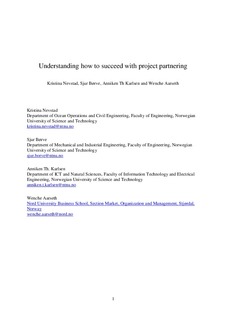| dc.contributor.author | Nevstad, Kristina | |
| dc.contributor.author | Børve, Sjur | |
| dc.contributor.author | Karlsen, Anniken Th | |
| dc.contributor.author | Aarseth, Wenche Kristin | |
| dc.date.accessioned | 2019-02-25T12:53:42Z | |
| dc.date.available | 2019-02-25T12:53:42Z | |
| dc.date.created | 2018-07-12T13:51:18Z | |
| dc.date.issued | 2018 | |
| dc.identifier.citation | International Journal of Managing Projects in Business. 2018, 11 (4), 1044-1065. | nb_NO |
| dc.identifier.issn | 1753-8378 | |
| dc.identifier.uri | http://hdl.handle.net/11250/2587252 | |
| dc.description.abstract | Purpose The purpose of this paper is to present new findings to organizations that acknowledge difficulties in implementing and succeeding with project partnering. Design/methodology/approach The investigation is based on a case study where empirical evidence has been collected via semi-structured interviews of 54 professionals within the construction industry. Findings Based on the research the authors were able to identify three main dimensions vital for project partnering success: 1. who related to participant selection; 2. what related to task clarification; and 3. way related to partnering means. These dimensions give rise to what the authors have termed a 3W (Who, What, Way) model on how to succeed with project partnering in practice. The third dimension, way related to partnering means, was found to consist of the four subdimensions: 3a. partnering attitude; 3b. a collaborative culture; 3c. a holistic perspective; and 3d. an accurate handover. Originality/value The authors found 318 papers focusing on partnering, in these only 19 focused on how to succeed with project partnering. The authors have complemented the limited research on how to succeed with project partnering with 54 interviews of professionals. The majority of the existing research has focused on challenges. This paper contributes to the research gap by presenting a 3W model on how to succeed with project partnering. | nb_NO |
| dc.language.iso | eng | nb_NO |
| dc.publisher | Emerald | nb_NO |
| dc.title | Understanding how to succeed with project partnering | nb_NO |
| dc.type | Journal article | nb_NO |
| dc.type | Peer reviewed | nb_NO |
| dc.description.version | acceptedVersion | nb_NO |
| dc.source.pagenumber | 1044-1065 | nb_NO |
| dc.source.volume | 11 | nb_NO |
| dc.source.journal | International Journal of Managing Projects in Business | nb_NO |
| dc.source.issue | 4 | nb_NO |
| dc.identifier.doi | 10.1108/IJMPB-07-2017-0085 | |
| dc.identifier.cristin | 1596926 | |
| dc.description.localcode | © 2018. This is the authors' accepted and refereed manuscript to the article. The final authenticated version is available online at: https://doi.org/10.1108/IJMPB-07-2017-0085 | nb_NO |
| cristin.unitcode | 194,64,93,0 | |
| cristin.unitcode | 194,64,92,0 | |
| cristin.unitcode | 194,63,55,0 | |
| cristin.unitname | Institutt for havromsoperasjoner og byggteknikk | |
| cristin.unitname | Institutt for maskinteknikk og produksjon | |
| cristin.unitname | Institutt for IKT og realfag | |
| cristin.ispublished | true | |
| cristin.fulltext | postprint | |
| cristin.qualitycode | 1 | |
